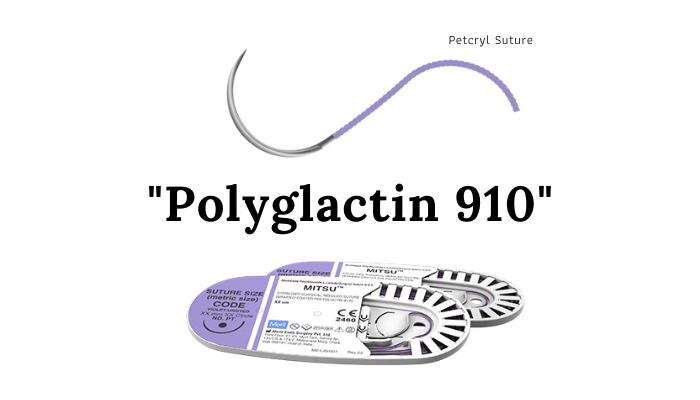Characteristics
It is a smooth, synthetic, multifilament, braided absorbable suture material, prepared from glycolic lactic acid polymer. It is inert, non-pyrogenic, non-antigenic and produces mild tissue reaction during absorption process. It has minimum tissue drag, easy to handle, smooth to tie down and unsurpassed knot security. It remains stable in contaminated wound.
Composition
Polyglactin 910 is a synthetic braided suture material consisting of glycolic acid (glycolide) and lactic acid (L-Lactide) in the ratio of 9:1. It is coated with equal parts of copolymer of Glycolide, Lactide and Clacium stearate which are non-pyrogenic in nature. This coating mixture is absorbable, water repelling, adherent and non-flaking which is ideal for coating. The suture material is sterilised by ethylene oxide and may be coated or uncoated, the former being easier to handle.
Colour
Polyglactin sutures are available in both dyed (voilet)/undyed (clear) and coated/uncoated forms.
Tensile Strength
Polyglactin provides long-term tensile strength and mid range of absorption time. Vicryl / Polyglactin material is absorbed by hydrolysis and assures predictable and reliable absorption. Knot placement precision of polyglactin 910 sutures is better than that of PGA sutures. Tensile strength and knot strength is reduced by 25% in two weeks and 40-50% tensile strength is retained after 3 weeks of implantation (for sutures larger than 6-0). Its complete absorption occurs in 56 to 70 days.
Polyglactin 910 sutures have an excellent size to strength ratio, relatively easy to handle, stable in contaminated wounds and elicit minimum tissue reaction.
Indications
This suture material is used in deep layer closures, ocular surgery (cataract, corneal, squint eye, trabeculectomy surgeries), Gastrointestinal surgeries, gynaecology & obstetric procedures, orthopaedic surgeries, Urological procedures, peripheral nerve anastmosis, plastic and reconstructive surgeries, microsurgeries, vascular anastmosis for vessels less than 2mm diameter, intracutaneous & subcutaneous skin closure, general ligatures/general surgical procedures and for closing muscles after laparotomy.
Contraindications
Use in biliary and urinary tract surgeries may result into calculus formation at the site due to prolonged contact with bile or urine.
Ployglactin sutures are not recommended in patients having known history of allergies to any of its components. And it may incite local irritation/inflammatory response or grade 1 reaction at the site of inflammation.
Size
Dyed and undyed polyglactin suture are available in various sizes (Dyed: 8/0 – 2 and Undyed: 6/0 – 2) with different suture lengths ranging from 35 -180 cm and different needles (9mm to 60 mm) or without needles. Double armed sutures are also available in the market.
Handling and Storage
General handling guidelines should be followed in order to avoid damage to suture or needle. Re-sterilization and reuse is not recommended. It should be stored between 15OC and 30OC, away from moisture and direct heat.
Examples
Mitsu, Vicryl, Petcryl Sutures
Fig: Dyed Polyglactin 910 or PGCL Suture by Dolphin Sutures
Fig. Mitsu – Polyglactin 910 absorbable suture
FAQs
Yes. Polyglactin 910 sutures are synthetic, multifilament braided absorbable sutures.
Vicryl suture is a synthetic suture material which is a copolymer of glycolide/glycolic acid and lactide/lactic acid in ratio of 9:1.
Monocryl is poliglecarpone monofilament suture while vicryl is a braided multifilament suture material. Both are absorbable suture materials.
Vicryl is coated with equal parts of copolymer of polyglactin 370 (Glycolide, Lactide) and Clacium stearate. It makes it more smooth and causes less tissue drag.
Vicry suture is available in dyed and undyed forms. Dyed vicryl suture is Violet in colour and undyed is white in colour.
Vicryl or polyglactin sutures are absorbable sutures. Coated Vicryl rapide are absorbed faster than vicryl plus and simple vicryl sutures. They do not need removal once implanted.
Vicryl suture is used for deep layer closures, ocular surgery, soft tissue surgeries, peripheral nerve anastmosis, plastic and reconstructive surgeries, microsurgeries, intracutaneous & subcutaneous skin closure, general ligatures/general surgical procedures and for closing muscles after laparotomy.
Vicryl mesh is an absorbable polyglactin 910 mesh used for wound support or organ support. It is of two types i.e. woven mesh and knitted mesh.
Vicryl 4-0 is a absorbable synthetic suture material. 4-0 is USP size which is equal to 1.5 metric gauge and 0.150-0.199 mm in diameter.
